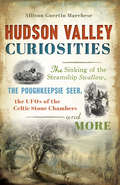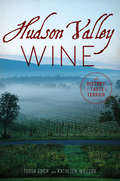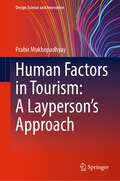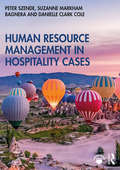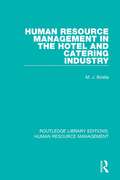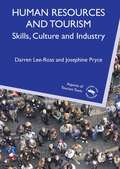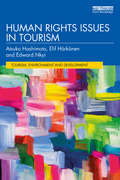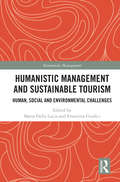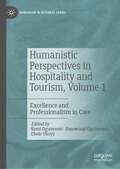- Table View
- List View
Hudson (Images of America)
by Lisa LamonicaHudson, with its scarlet past, is still intriguing in many ways. It is the new go-to destination being discovered by tourists, chefs, world-famous artists and celebrities, motion pictures, and major magazines. Visitors say there is a palpable vibe of creative energy. Home to the largest number of self-employed people in New York, Hudson is a unique city where one can start their own business and not feel out of place. In vintage photographs, Hudson covers a rich history that includes the story of the Mohicans, whaling, and the multitude of factories in the Industrial Age, as well as the city's modern-day transformation.
Hudson River Lighthouses (Images of America)
by Hudson River Maritime MuseumSet against the backdrop of purple mountains, lush hillsides, and tidal wetlands, the lighthouses of the Hudson River were built between 1826 and 1921 to improve navigational safety on a river teeming with freight and passenger traffic. Unlike the towering beacons of the seacoasts, these river lighthouses were architecturally diverse, ranging from short conical towers to elaborate Victorian houses. Operated by men and women who at times risked and lost their lives in service of safe navigation, these beacons have overseen more than a century of extraordinary technological and social change. Of the dozens of historic lighthouses and beacons that once dotted the Hudson River, just eight remain, including the iconic Statue of Liberty, New York Harbor's great monument to freedom and immigration, which served as an official lighthouse between 1886 and 1902. Hudson River Lighthouses invites readers to explore these unique icons and their fascinating stories.
Hudson River Towns: Highlights from the Capital Region to Sleepy Hollow Country (Excelsior Editions)
by Joanne MichaelsThe cities, towns, and villages along the banks of the Hudson River are the lifeblood of a region bursting with historic sites, cultural attractions, and natural beauty. Hudson River Towns pairs the spectacular work of renowned Hudson Valley photographer Hardie Truesdale with the vivid descriptions of Joanne Michaels, one of the region's most experienced travel writers. Together they document, in words and photographs, the dynamic nature of the river's population centers, offering readers a captivating personal journey down the Hudson River.Although Main Street continues to struggle across America, there has been a movement afoot in the Hudson Valley to support local enterprise, and many of the region's communities are currently enjoying a renaissance. Newburgh, for instance, has a beautiful waterfront and a new crop of businesses emerging in the inner city. Poughkeepsie's "Walkway Over the Hudson" has drawn thousands of visitors since its opening in 2009, turning the city's Mount Carmel neighborhood, once a sleepy Italian enclave, into a tourist destination. And Kingston was recently named one of the top ten most desirable—and affordable—cities in America for artists. Festivals, parks, and recreational activities are part of the fabric of contemporary Hudson Valley life, and they are represented in these pages as well.The journey begins in the Upper Hudson River region, stopping in Albany, Coxsackie, Athens, Hudson, and Catskill; continues through the Mid-Hudson River region, featuring Saugerties, Kingston, Poughkeepsie, Newburgh, Beacon, Cold Spring, and Garrison; and culminates in the Lower Hudson River towns of Peekskill, Nyack, Tarrytown, and Piermont. With more than 120 full-color photographs that lavishly display the dramatic faces of these cities, towns, and villages, Hudson River Towns reveals a dimension of the region unseen by most travelers and local residents, who will be inspired to think differently about their surroundings after taking this armchair journey through one of America's most beautiful and historic regions.
Hudson River Valley Farms: The People And The Pride Behind The Produce
by Joanne MichaelsMeet your local farmer! Published for the 400th anniversary of Henry Hudson&’s September 1609 journey along the river that today bears his name, this fascinating illustrated portrait celebrates the local farms—and farmers—in one of the country&’s most scenic and storied regions, once known as the Breadbasket of America. Hudson River Valley Farms brings to life the renaissance of food producers who have developed the region as a source of artisanal cheeses, grass-fed beef, and first-rate organic fruits and vegetables. Stunning photography and short, evocative essays take you on a rare, behind-the-scenes journey to forty-four farms from Westchester County to the Capital District of Albany, and include the colorful maverick entrepreneurs behind the striking scenery. The book also includes a directory of nearly 100 local farmers&’ markets, directions to the featured farms, and an introduction by the region&’s popular U.S. Congressman, Maurice Hinchey.
Hudson River Valley National Heritage Area: Heritage Site Guidebook, Second Edition
by Hudson River Valley National Heritage AreaTraveling down the Hudson River, named by Native Americans the river that flows both ways, you discover people, places, and events that made American history. The cultural, historic, and scenic resources of the Hudson Valley are so numerous, so varied, and so compelling that it's no wonder Congress recognized the Hudson River Valley as a National Heritage Area in 1996. The National Park Service called the region the "landscape that defined America" and characterized the valley as "an exceptionally scenic landscape that has provided the setting and inspiration for new currents of American thought, art, and history." Its political importance was demonstrated early in our history when the river played a critical role in the Revolutionary War. The many streams and waterfalls of the tributaries of the Hudson River powered early sawmills and gristmills. The river and its landscapes inspired the Hudson River school of painters. Sublime and picturesque paintings by Thomas Cole, Frederic Church, and Asher Durand depicted this unique American landscape for the world to witness. Industrialists and commercial leaders like William and John D. Rockefeller, Frederick Vanderbilt, J. P. Morgan, and Ogden Mills built their great estates along the Hudson River.The second edition includes completely updated user-friendly design and vibrant photography; heritage site pages that include brief descriptions, contact information, and accessibility site characteristics; and National Park Service Passport Stamp locations with new cancellation stamp pages for your collection.Heritage sites in this guidebook are associated with areas of interest and categorized as must see, best bet, or special interest to make it easy to explore the stories of the Hudson River Valley. Heritage sites are also organized by geography and proximity to make it easy to find heritage sites nearby.
Hudson Valley Chef's Table: Extraordinary Recipes From Westchester to Columbia County (Chef's Table)
by Julia SextonThousands of years before Hendrik Hudson sailed his Half Moon up to modern day Albany in 1609, the glaciers that once blanketed the Hudson Valley retreated to the Arctic. What the ice left in its wake was a soil so rich that, in global satellite images taken today, the trench of its path still shows up as a jet black streak. Lured by this soil&’s fertility came the family farmers of the Hudson Valley, who, over time, learned to glean the finest products that the land could provide. Today the Hudson Valley is an area rich in history and art, antiques and architecture, charming towns, and farms that produce bountiful local produce. America&’s history comes alive here as does its beauty. Naturally, Hudson Valley restaurants boast outstanding chefs with a deep and growing commitment to supporting local agriculture. Hudson Valley farmers and artisans fill out the menus with sustainable raised produce, meats, poultry, eggs, cheese, wine and other fine foods. It&’s creative cuisine at its bestWith over 80 recipes for the home cook from the state&’s most celebrated eateries and showcasing full-color photos featuring mouth-watering dishes, famous chefs, and lots of local flavor, Hudson Valley Chef&’s Table is a feast for the eyes as well as the palate. The delicious dishes featured here are personal histories––stories of people and place. Each recipe, chef profile, and photo tells its part of the story and magic of the Hudson Valley.
Hudson Valley Curiosities: The Sinking of the Steamship Swallow, the Poughkeepsie Seer, the UFOs of the Celtic Stone Chambers and More
by Allison Guertin MarcheseHudson Valley is steeped in mysteries, from Celtic chambers resting in the deep woods of Putnam to Millbrook�s abandoned Bennett College. In the Highlands, Iroquois chief Daniel Nimham gave his life for the cause of American independence. One strange night in the Catskills, a legendary playwright miraculously survived a midnight plunge off the suspended Schoharie Bridge. The great passenger steamship Swallow sank near the shores of Athens. Author Allison Guertin Marchese reveals a treasure-trove of curious tales recounting the most uncommon history of bad guys, bold girls, creepy colleges, missing mastodons and more in this wondrous region of New York.
Hudson Valley Wine: A History of Taste & Terroir (American Palate)
by Tessa Edick Kathleen WillcoxAlthough it’s the birthplace of American wine, Hudson Valley vintages have yet to meet with the renown of those produced by the neighboring Finger Lakes and Long Island. In the 1600s, French Huguenots arrived in the area and used their French winemaking skills to found vineyards. Benmarl is cultivating astounding varietals from a vineyard that has continuously grown grapes since 1772. Recently launched cooperative winemaking organizations have made strides in the region, and scientists at Cornell University have worked to determine the tastiest varietals and hybrids that will flourish in the challenging Hudson Valley terroir. Hudson Valley wines are at last garnering critical acclaim in mainstream national publications and restaurants. Tessa Edick and Kathleen Willcox uncover the hundreds of years, unrelenting pride, determination and ingenuity behind Hudson Valley wines.
Hudson-Fulton Celebration of 1909
by Roger Panetta Edward F. LevineThe Hudson-Fulton Celebration of 1909 honored the tercentennial of Henry Hudson's great find for the Dutch and the centennial of Robert Fulton's steamboat. These events anchored settlements along the Hudson River valley and helped to define this famous region. The celebration, which coincided with the heyday of the penny postcard, was a multi-week, cross-state parade and party. Among its many vintage images, Hudson-Fulton Celebration of 1909 features unique postcards from the magnificent event by blockbuster artist Bernhardt Wall, renowned publisher Raphael Tuck, and an official souvenir series from the Redfield Brothers.
Hueco Tanks Climbing and Bouldering Guide (Regional Rock Climbing Series)
by John ShermanA guide to the most important bouldering area in North America by the master himself.
Human Factors in Tourism: A Layperson's Approach (Design Science and Innovation)
by Prabir MukhopadhyayThe textbook covers the application of human factors in different facets of tourism and hospitality industry. It talks about appropriate ambience creation for guests, so they can enjoy their stay. This book enumerates different human factors aspects of dealing with tourists, conducting guided tours, or ensuring that tourists are completely satisfied from the tour in detail but in a layperson’s language. This book discusses details of the application of human factors in the tourism sector. This book aims to fill the gap between the literature available on tourism that deals with people and human factors that deals with the interaction among people, space, and products. This book aids the students and instructors in understanding and teaching different human factors issues in this sector. Further, this book will help professionals in the industry in providing quality services to their clients.
Human Resource Management for Hospitality, Tourism and Events
by Dennis NicksonPlease note: this title will publish in January 2012. This textbook explores the policies and practices employed in the management of people working in the tourism, hospitality and events industries. It considers the nature of these industries and the varied approaches that organizations take with the handling of matters such as recruitment, health and welfare and remuneration. This book is enriched with topical case studies that describe and illustrate the human resource management behaviour of airlines, hotel chains and other international companies in the sector, providing real world industry perspective. With a clear, reader friendly layout containing chapter outlines and objectives and examples of best practice, this is the ideal guide to HRM for any student on a hospitality, tourism or related course.
Human Resource Management for the Event Industry (Events Management)
by Lauren White Lynn Van Der WagenHuman Resource Management for Events still remains the only text to introduce students to the unique application of HR principles in the context of a highly complex event environment. Linking theory, research and application it looks at the purpose and processes of managing such a sizable & varied workforce in a highly pressured environment through the differing and various types of events from sporting to arts to business events.Since the first edition, there have been many important developments in this field and this second edition has been completely revised and updated in the following ways: extensively updated content to reflect recent issues and trends including: labour markets and industry structure, impacts of IT and social media, risk management, volunteer motivation, talent management, equal opportunities and managing diversity. All explored specifically within the Events Industry extended volunteer chapter, including new material on ethics, volunteer motivation and satisfaction. a new chapter on Internal Communications, looks at how an effective internal communication plan can be achieved which is a critical part of HR strategy in the unique event environment. updated and new international case studies throughout to explore key issues and show real life applications of HRM in the Events Industry. supported with new lecturer and students online resources including: power point slides, suggested answers to review questions, web & video links to additional resources and a student test bank. Written in a user friendly style, each chapter includes international examples, bulleted lists, guides to further reading and exercises to test knowledge.
Human Resource Management for the Hospitality and Tourism Industries
by Dennis NicksonHuman Resource Management for the Hospitality and Tourism Industries takes an integrated look at HRM policies and practices in the tourism and hospitality industries. Utilising existing human resource management (HRM) theory and practice, it contextualises it to the tourism and hospitality industries by looking at the specific employment practices of these industries, such as how to manage tour reps or working in the airline industry.It initially sets the scene with a broad review of the evidence of HRM practice within the tourism and hospitality industries. Having identified the broader picture, the text then begin to focus much more explicitly on a variety of HR policies and practices such as:* recruitment and selection: the effects of ICT, skills required specific for the industry and the nature of advertising* legislation and equal opportunities: illegal discrimination and managing diversity * staff health and welfare: violence in the workplace, working time directives, smoking and alcohol and drug misuse* remuneration strategies in the industry: the 'cafeteria award' approach, minimum wage and tippingHuman Resource Management for the Hospitality and Tourism Industries is illustrated throughout with both examples of best practice for prescriptive teaching and discussion, and international case studies to exercise problem solving techniques and contextualise learning. It incorporates a user friendly layout and includes pedagogic features such as: chapter outlines and objectives, HRM in practice - boxed examples, reflective review questions, web links' discussion questions and further reading.Accompanying the text are online supplementary lecturer materials including downloadable figures from the book, PowerPoint slides, further cases and extra exercises and points for discussion.
Human Resource Management in Hospitality Cases
by Peter Szende Suzanne Markham Bagnera Danielle Clark ColeHuman Resource Management in Hospitality Cases adopts a practical case-based approach to develop critical thinking and problem-solving skills in future hospitality managers. Using tried-and-tested real-life scenarios, this book thoroughly prepares hospitality students for a career in the field. Chapters are comprised of 75 short vignettes, split into nine sections that reflect and cover the primary challenges facing hospitality managers on a daily basis, including leadership credibility, building and managing employee performance, managing a diverse workforce, dealing with problem behaviors, and many others, all contextualised within the hospitality industry. With a main "think point" and series of questions for each case, the book is a highly insightful and engaging read. Suggested answers and solutions to the questions can be found within the extensive online resources that complement the book. Each section is also contextualized and theorized with an additional reading section, organized by key concept. This book will be essential for all students of hospitality and an invaluable resource for current practitioners in the field as well.
Human Resource Management in the Hospitality Industry
by Michael Boella Steven Goss-TurnerNow in its eighth edition, Human Resource Management in the Hospitality Industry: an introductory guide, is fully updated with new legal information, data, statistics and examples, and includes brand new material on multi unit operations and management.Taking a 'process' approach, it guides the reader through every stage from HR planning through recruitment to termination/separation, covering the following issues:* Selection, appointment and induction* Training and management development* Labour turnover* Employee relations and employment law* Managing people and customer care* Business EthicsWritten in a user friendly style, each chapter includes international examples, bulleted lists, guides to further reading and exercises to test knowledge.
Human Resource Management in the Hospitality Industry: A Guide to Best Practice
by Michael Boella Steven Goss-TurnerNow in its ninth edition, Human Resource Management in the Hospitality Industry: A Guide to Best Practice, is fully updated with new legal information, data, statistics and examples. Taking a 'process' approach, it provides the reader with an essential understanding of the purpose, policies and processes concerned with managing an enterprise's workforce within the current business and social environment. Since the eighth edition of this book there have been many important developments in this field and this ninth edition has been completely revised and updated in the following ways: Extensively updated content to reflect recent issues and trends including: labour markets and industry structure, impacts of IT and social media, growth of international multi - unit brands, role of employer branding, talent management, equal opportunities and managing diversity. All explored specifically within the Hospitality Industry The text explores key issues and shows real life applications of HRM in the Hospitality industry and is informed through the authors' research projects within Mitchells & Butler's plc, Pizza Express, Marriott Hotels and Café Rouge. An extended case study drawing from the authors' experience working with Forte and Co., Centre hotels, Choice Hotels and Bass, Price Waterhouse and Grant Thornton Written in a user friendly style and with strong support from the Institute of Hospitality, each chapter includes international examples, bulleted lists, guides to further reading and exercises to test knowledge.
Human Resource Management in the Hospitality Industry: A Guide to Best Practice
by Steven Goss-Turner Michael J. BoellaHuman Resource Management in the Hospitality Industry: A Guide to Best Practice takes a ‘process’ approach and provides the reader with an essential understanding of the purpose, policies and processes concerned with managing an enterprise’s workforce within the current business and social environment. Since the ninth edition of this book there have been many significant developments in this field and this new edition has been completely revised and updated in the following ways: Extensively updated content to reflect recent issues and trends relevant to the hospitality industry including: changing labour market profiles and the ‘gig’ economy, the digital transformation of HRM practices, employer branding developments, talent management strategies, employee well-being considerations, and contemporary concerns over diversity, gender and harassment at work. Five new chapters on: organizational culture, modern labour markets, emotions and well-being, careers in hospitality, and digital HRM. New international case studies throughout to explore key issues and show real-life applications of HRM in the hospitality industry. Written in a user-friendly style, each chapter includes international examples, bulleted lists, guides to further reading and exercises to test knowledge.
Human Resource Management in the Hospitality and Tourism Industry
by Michael RileyThis fully updated and expanded second edition of Human Resource Management examines the role of human resource management in the hospitality and tourism industry. The subject is approached from four perspectives: * the social psychology of managing people * the economics of labour * the practical techniques * strategy. The author argues that labour costs, labour utilisation, labour market behaviour and pay are inseparable from the skills of managing people. The book contains an important analysis of the labour market for this industry and now, in its second edition includes, among others, chapters on attitude measurement, customer-employee relations, questionnaire design and organizational change. Human Resource Management in the Hospitality and Tourism Industry is written in a clear, user-friendly style and offers a challenging view of the subject and an opportunity to learn an important aspect of management in an applied context. It is appropriate for degree level students and practitioners in the industry.
Human Resource Management in the Hotel and Catering Industry (Routledge Library Editions: Human Resource Management)
by M. J. BoellaThis book, first published in 1987, gives valuable insights into the characteristics of employment in the hotel and catering industry and useful guidance on personal techniques. It deals with fundamental issues, such as personnel policy, as well as with practical techniques. Human Resource Management in the Hotel and Catering Industry has been written as an introductory text to human resource management in the hospitality industry. It is suitable reading for students, line managers and personnel managers in the many different sectors of the business.
Human Resources and Tourism
by Darren Lee-Ross Josephine PryceThe tourism industry provides employment for literally millions of individuals. Despite global recessions, terrorist attacks and other catastrophes this is likely to remain unchanged in the long-term. Resilience of this nature helps tourism remain a major global employer in both developed and emerging economies. The important role played by tourism workers cannot be overstated; some argue that they actually define the product on offer. Accordingly, mediocre or poor performance gives rise to an unremarkable service experience or one to which customers would not return willingly. The inextricable link between the calibre and performance of staff and service delivery is a key issue for human resources management. This challenge is further complicated by a number of structural characteristics including: dominance of unaffiliated small to medium-sized organizations; high levels of labour turnover; and a heterogeneous workforce with individuals having a wide variety of cultural differences and employment aspirations. This book accounts for the above factors using an approach which is part prescriptive and part enquiry or research-oriented. In doing so, espoused 'HRM convention' may be understood against 'HRM in practice'. Additionally, by using this method we hope to instil a sense of enquiry in the reader. This is a necessary intellectual asset for the future and will also allow the individual to make a positive contribution in the workplace.
Human Rights Issues in Tourism (Tourism, Environment and Development Series)
by Atsuko Hashimoto Elif Harkonen Edward NkyiThis book uniquely focuses on human rights issues associated with tourism development and tourism businesses. Tourism is a manifestation of globalization and it intersects with human rights on so many levels. These implications are increasingly relevant in light of the COVID-19 pandemic and subsequent global economic hardship. Split into two main sections, the first establishes a background to human rights issues with reference to tourism, and the second provides a multi-disciplinary analysis of a range of selected human rights issues in tourism; these include displacement, security, privacy, discrimination, freedom of movement, the rights of Indigenous people, sex tourism and labour conditions. All chapters include case studies to showcase specific issues such as legal rulings or tourism policies/regulations. This book is written by a highly regarded team of authors specializing in tourism studies and human rights law. This significant volume on the interaction between tourism development and the safeguarding of human rights will be of interest to a variety of disciplines, in the fields of tourism, political science and tourism/human rights.
Human-Animal Relations in Tourism, Leisure and Development: Perspectives from Latin America
by Katherine Dashper Carlos Monterrubio Xavier López-Medellín Helen WadhamHumans and animals have developed multiple and complex interactions in the fields of tourism, leisure, and development. However, much of the existing research on how humans and animals interact in these fields has emerged from within the context of developed countries. As a result, little has been documented about human-animal interactions in the socioeconomic, cultural, and environmental contexts of countries in the Global South. Specifically, the diversity and complexity of interspecies relationships in tourism, leisure, and local development in Latin America have been largely ignored in Anglo-Saxon literature. This has resulted in a limited, partial, and hegemonic understanding and debate about human-animal relationships globally, dominated by certain regions of the world. This book addresses this gap by documenting multiple and complex relationships between humans and animals in the fields of tourism, leisure, and local development in countries in Latin America. The book: Brings together empirical and conceptual works that reveal different disciplinary, theoretical, ethical, methodological, and practical perspectives. Reveals how human-animal relationships - both domestic and wild - can result in co-created interspecies experiences, conflicts, conservation efforts, welfare, and local development of human societies in the region. Equips stakeholders with conceptual frameworks and actionable tools to formulate policies that blend animal welfare and sustainability in Latin American tourism and recreation strategies. Challenges dominant narratives from the Global North regarding tourism and conservation, promoting a more inclusive and nuanced approach. This book will be of interest to researchers, professionals and policymakers within tourism, leisure, animal welfare, conservation and destination development.
Humanistic Management and Sustainable Tourism: Human, Social and Environmental Challenges (Humanistic Management)
by Maria Della Lucia Ernestina GiudiciTourism is a fast-growing and changing industry, which has become a driver of economic development in both developed and underdeveloped countries. While the tourism industry’s potential for shared value creation and sustainable development is acknowledged, the concerns around the environmental and social pressures remain a challenge for businesses, organizations, and destinations. This is because sustainable tourism arguably conflicts with the predominant neoliberal structure of the economy and with the hierarchical, profit- and consumption-driven societies. The emphasis on competition, growth, and profitability may undermine economic viability itself by consuming unreproducible resources and by undermining the six essential elements—dignity, people, prosperity, social justice, planet, and partnership—that are conceptually linked to sustainable development. The crises recurrently challenging the global travel and tourism environment, including climate change, bushfires, extreme weather disasters, pandemics, and the financial crisis, show the weaknesses of neoliberal approaches and the collective economic dependency of countries on tourism that is vulnerable, if not completely unsustainable. This vulnerability asks for understanding that the collective future depends on developing entirely new approaches and interpretation of tourism to effectively respond to the human, societal, social, and climate challenges. This book offers a novel and original perspective entailing the application of a humanistic management approach to sustainable tourism, which is centered on the value of human life, the protection of human dignity and the promotion of well-being. Multiple theoretical approaches, methods, and practical cases, on an international scale, shed light on shared value creation and human dignity as a necessary condition for its achievement in different contexts. Implicitly and explicitly, they respond to the current urgency to implement strategies to recover from the worldwide impact of the pandemic crisis and to provide a vision of what tourism could and should be when it recovers. It will be of interest to researchers, academics, professionals, and postgraduates in the fields of management, sustainability, and tourism development.
Humanistic Perspectives in Hospitality and Tourism, Volume 1: Excellence and Professionalism in Care (Humanism in Business Series)
by Kemi Ogunyemi Ebele Okoye Omowumi OgunyemiThis book, the first of two volumes, uses a framework of philosophical anthropology, and the concepts of humanistic leadership and humanistic management, to explore the value of work in the hospitality and tourism industry. It presents robust theoretical and practical implications for professionalism and excellence at work. This volume addresses the hospitality professional, beginning with an exploration of the foundational literature, before moving on to discuss topics like the concept of human dignity at work, how one can find meaning within the hospitality industry, spirituality at work, philosophy in the world of work, and personal development. These volumes will be of use to academics and practitioners in the fields of hospitality and tourism management, humanistic and transformational leadership, corporate social responsibility, human resource management, customer service, and workplace spirituality.






